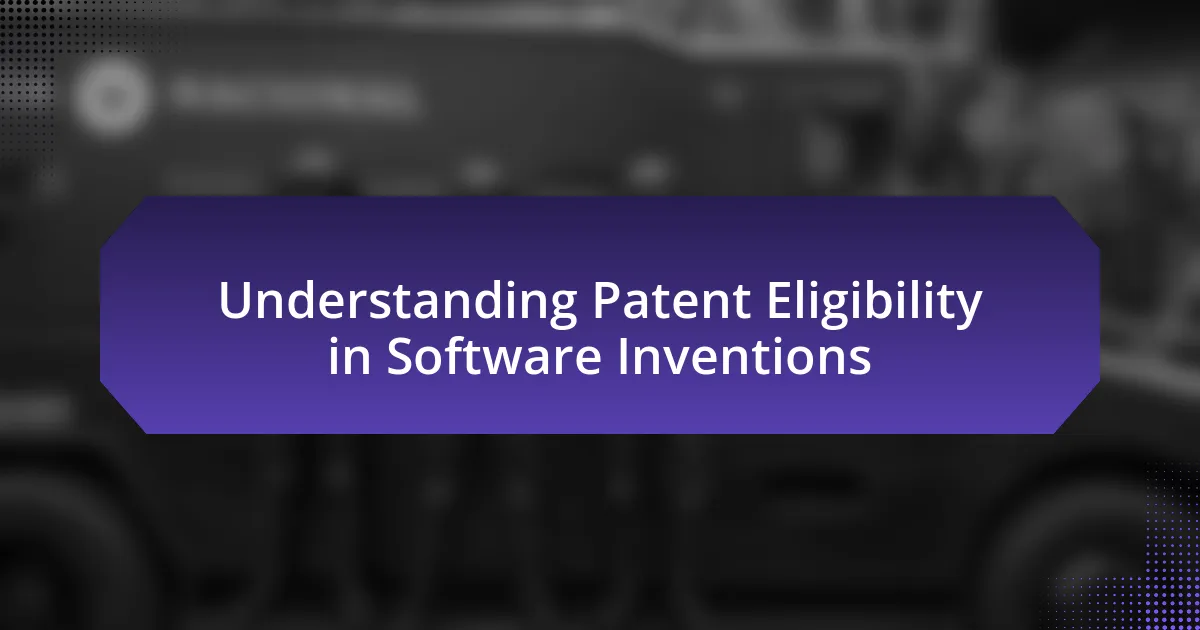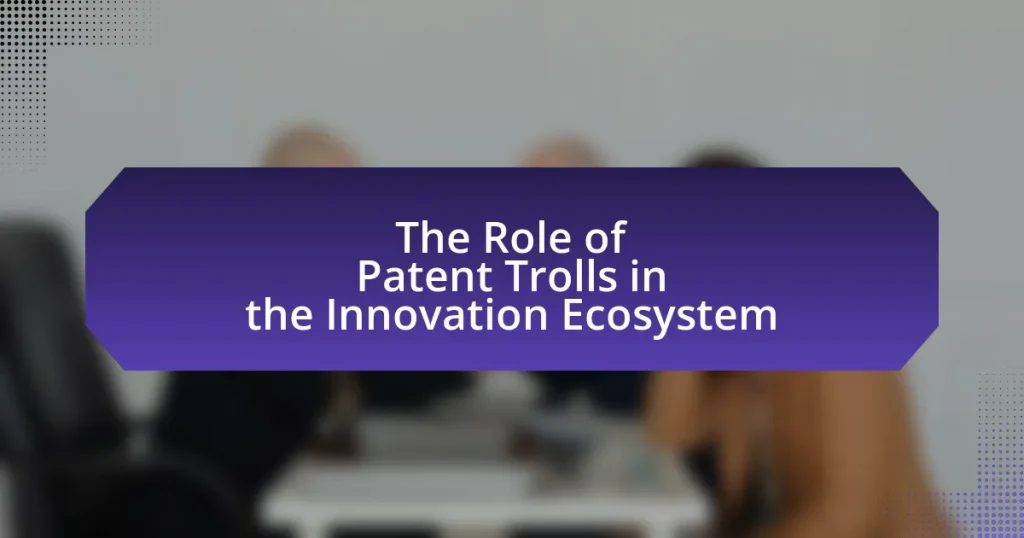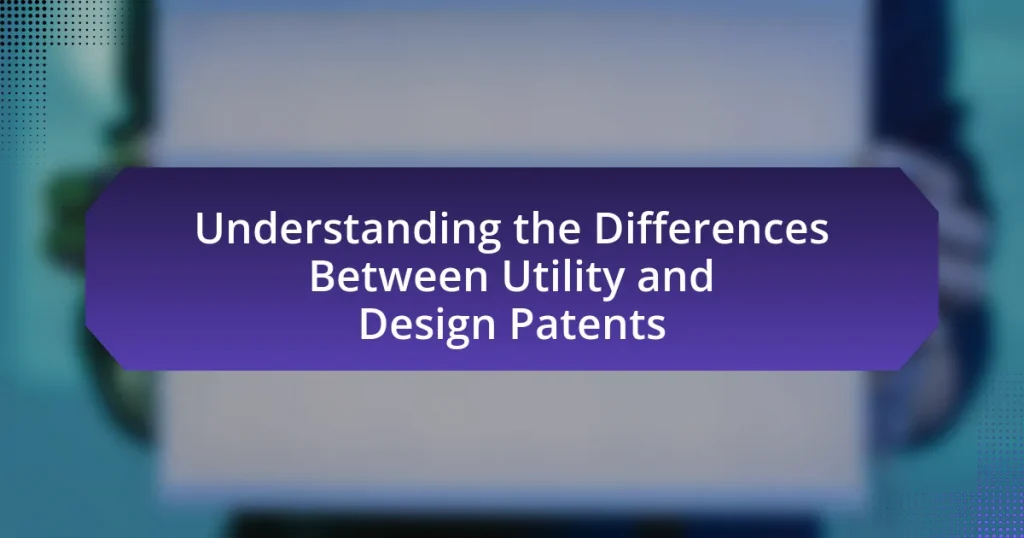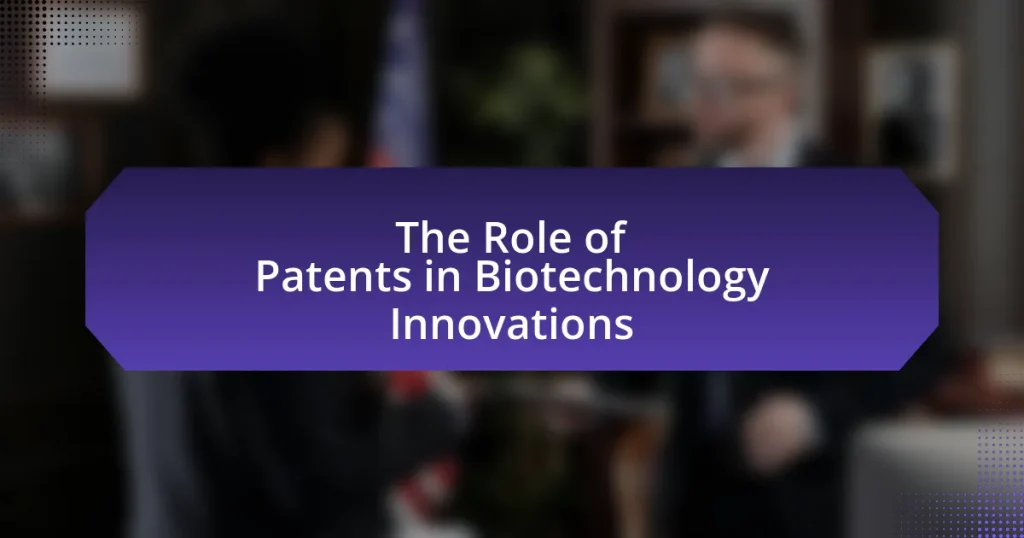Patent eligibility in software inventions refers to the legal criteria that determine whether a software-related invention can be patented, primarily governed by Title 35 of the United States Code. Key requirements include novelty, non-obviousness, and usefulness, alongside the necessity for the invention to fall within statutory categories such as processes or machines. The U.S. Supreme Court’s ruling in Alice Corp. v. CLS Bank International established a two-step test for assessing patent eligibility, focusing on abstract ideas and inventive concepts. This article explores the importance of patent eligibility for fostering innovation, the challenges inventors face, the role of the U.S. Patent and Trademark Office, and the impact of international patent laws on software inventions. Additionally, it discusses future trends and best practices for navigating the complexities of patent applications in the evolving technological landscape.
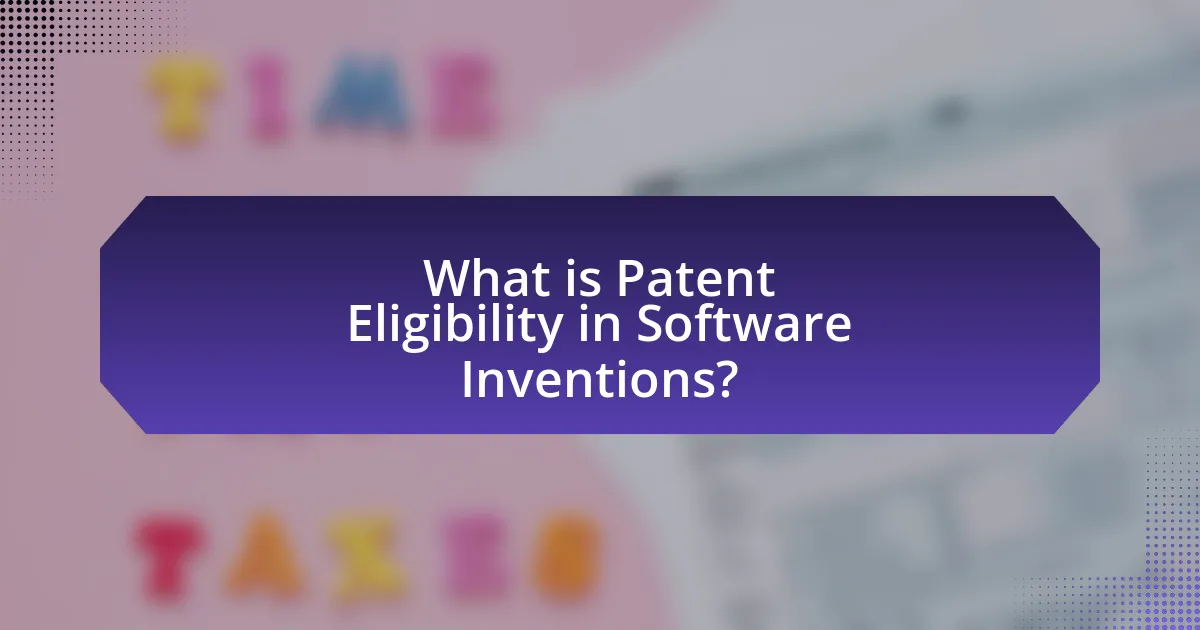
What is Patent Eligibility in Software Inventions?
Patent eligibility in software inventions refers to the legal criteria that determine whether a software-related invention can be patented. In the United States, for an invention to be patentable, it must meet the requirements of being novel, non-obvious, and useful, as outlined in Title 35 of the United States Code. Additionally, the invention must fall within one of the statutory categories, which include processes, machines, manufactures, or compositions of matter. The U.S. Supreme Court’s decision in the 2014 case Alice Corp. v. CLS Bank International established a two-step test to assess whether a software invention is eligible for patent protection, focusing on whether the claims are directed to an abstract idea and, if so, whether they contain an inventive concept that transforms the abstract idea into a patent-eligible application. This ruling has significantly influenced the patentability of software inventions, leading to a more stringent examination of their eligibility.
Why is Patent Eligibility Important for Software Inventions?
Patent eligibility is crucial for software inventions because it provides legal protection that encourages innovation and investment in technology development. When software inventions are patentable, inventors can secure exclusive rights to their creations, preventing unauthorized use and enabling them to monetize their innovations. This legal framework fosters a competitive market, as companies are incentivized to invest in research and development, knowing that their intellectual property will be safeguarded. According to the United States Patent and Trademark Office, patent protection can lead to increased funding opportunities and partnerships, ultimately driving technological advancement and economic growth.
What criteria determine patent eligibility for software inventions?
Patent eligibility for software inventions is primarily determined by the criteria of being novel, non-obvious, and useful, along with meeting the requirements of being directed to a patentable subject matter. Specifically, the invention must not be an abstract idea, as established by the U.S. Supreme Court in the Alice Corp. v. CLS Bank International decision, which clarified that software must provide a specific, practical application or improvement to technology. Additionally, the invention must be adequately described in the patent application, enabling a person skilled in the art to reproduce the invention. These criteria ensure that software inventions contribute meaningfully to the technological landscape and are not merely theoretical concepts.
How does patent eligibility impact innovation in the software industry?
Patent eligibility significantly influences innovation in the software industry by determining which software inventions can be legally protected and commercialized. When patent eligibility is broad, it encourages investment in research and development, as companies can secure exclusive rights to their innovations, leading to increased competition and technological advancements. Conversely, restrictive patent eligibility can stifle innovation by limiting the scope of what can be patented, discouraging developers from investing time and resources into new ideas due to the fear of infringing on existing patents or the inability to protect their own innovations. For instance, the U.S. Supreme Court’s decision in the 2014 case of Alice Corp. v. CLS Bank International narrowed the criteria for software patents, resulting in a decline in patent applications in the software sector, which some studies link to reduced innovation activity.
What are the key legal frameworks governing Patent Eligibility?
The key legal frameworks governing patent eligibility include the United States Patent Act, specifically Title 35 of the United States Code, and the Supreme Court’s interpretations, particularly the decisions in Mayo Collaborative Services v. Prometheus Laboratories, Inc. and Alice Corp. v. CLS Bank International. The United States Patent Act outlines the criteria for patentability, which includes novelty, non-obviousness, and usefulness. The Supreme Court’s rulings have clarified that abstract ideas, laws of nature, and natural phenomena are not patentable, establishing a significant precedent for evaluating software inventions. These legal frameworks collectively shape the standards for what constitutes a patentable invention in the context of software and technology.
What role does the U.S. Patent and Trademark Office play in software patents?
The U.S. Patent and Trademark Office (USPTO) is responsible for examining and granting patents for software inventions. The USPTO evaluates patent applications to determine if they meet the criteria of novelty, non-obviousness, and usefulness, as outlined in U.S. patent law. Specifically, the USPTO has issued guidelines that clarify how software-related inventions can be patented, emphasizing that they must provide a technical solution to a technical problem and not merely be abstract ideas. These guidelines are informed by landmark court decisions, such as the Supreme Court’s ruling in Alice Corp. v. CLS Bank International, which established a framework for assessing the patent eligibility of software inventions.
How do international patent laws affect software inventions?
International patent laws significantly influence software inventions by determining their eligibility for patent protection across different jurisdictions. Various countries have differing criteria for what constitutes a patentable software invention; for instance, the United States allows for the patenting of software if it produces a “useful, concrete, and tangible result,” while the European Patent Office requires that software must have a technical character to be patentable. This disparity can lead to challenges for software developers seeking protection, as they must navigate a complex landscape of regulations that can vary widely. Furthermore, international treaties like the Agreement on Trade-Related Aspects of Intellectual Property Rights (TRIPS) establish minimum standards for patent protection, but individual countries retain the authority to define the specifics of software patentability, resulting in a patchwork of legal frameworks that can affect innovation and investment in software technologies.
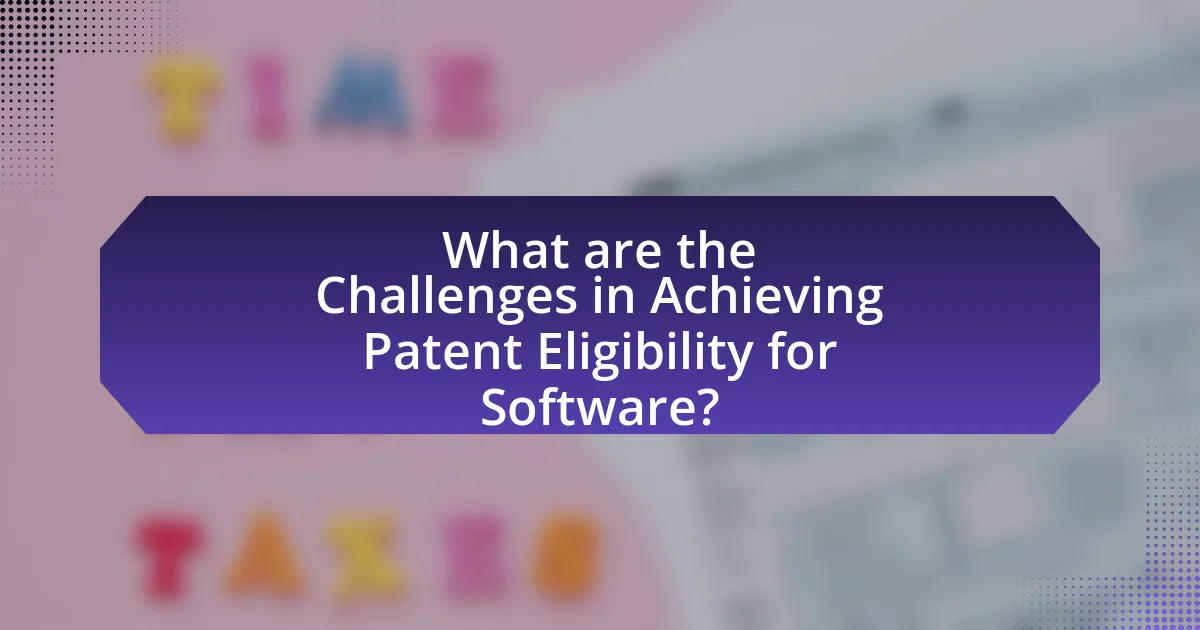
What are the Challenges in Achieving Patent Eligibility for Software?
The challenges in achieving patent eligibility for software primarily stem from the requirement that the invention must be novel, non-obvious, and useful, while also meeting the criteria of being a patentable subject matter. Software often faces scrutiny under the “abstract idea” doctrine, which can lead to rejection if the software is deemed to merely implement an abstract idea without adding significant inventive concepts. For instance, the U.S. Supreme Court’s decision in Alice Corp. v. CLS Bank International established a two-step framework that evaluates whether a claim is directed to a patent-ineligible concept and whether it includes an inventive concept sufficient to transform the claimed abstract idea into a patent-eligible application. This ruling has made it increasingly difficult for software patents to be granted, as many software inventions are viewed as lacking the necessary technical specificity or practical application.
What common obstacles do inventors face in patenting software inventions?
Inventors face several common obstacles in patenting software inventions, primarily related to patent eligibility, prior art, and the complexity of legal requirements. Patent eligibility is a significant hurdle, as software inventions must demonstrate that they provide a novel and non-obvious technical solution to a problem, which can be challenging given the abstract nature of software. Additionally, prior art searches can reveal existing patents or publications that may invalidate a new application, complicating the process. Furthermore, the legal requirements for drafting claims that adequately protect the invention while satisfying patent office standards can be intricate and require specialized knowledge. These challenges are underscored by the fact that many software patents are rejected due to failure to meet these criteria, as evidenced by the high rates of rejection in the United States Patent and Trademark Office.
How does the abstract idea exception affect software patent applications?
The abstract idea exception significantly limits the patentability of software applications by excluding inventions that are deemed to be merely abstract ideas without any concrete implementation. This principle, established in landmark cases such as Alice Corp. v. CLS Bank International, requires that software patents demonstrate an inventive concept that transforms the abstract idea into a patent-eligible application. Consequently, many software patent applications face rejection if they fail to show how the claimed invention applies the abstract idea in a specific, practical manner, thus emphasizing the need for clear, technical details in the application to meet eligibility standards.
What are the implications of the Alice/Mayo test on software patents?
The Alice/Mayo test significantly impacts software patents by establishing a two-step framework to determine patent eligibility. This test requires courts to first assess whether a claim is directed to a patent-ineligible concept, such as an abstract idea, and then evaluate if the claim includes an inventive concept that transforms the abstract idea into a patentable application. As a result, many software patents face increased scrutiny and rejection, particularly those that do not demonstrate a specific technological improvement or practical application beyond mere abstract ideas. This shift has led to a decline in the number of granted software patents, as evidenced by the U.S. Patent and Trademark Office’s reports indicating a rise in rejections based on the Alice/Mayo framework.
How can inventors navigate the complexities of patent eligibility?
Inventors can navigate the complexities of patent eligibility by thoroughly understanding the criteria set forth by patent offices, particularly the requirements of novelty, non-obviousness, and utility. These criteria dictate that an invention must be new, not obvious to someone skilled in the field, and must have a specific, substantial utility. For instance, the U.S. Patent and Trademark Office (USPTO) provides guidelines that clarify what constitutes a patentable invention, emphasizing the importance of detailed documentation and claims that clearly define the invention’s unique aspects. Additionally, engaging with patent attorneys who specialize in intellectual property can provide tailored advice and strategies to address specific challenges related to software inventions, ensuring compliance with legal standards and enhancing the likelihood of successful patent applications.
What strategies can be employed to enhance the chances of patent approval?
To enhance the chances of patent approval, applicants should ensure their invention is novel, non-obvious, and adequately described. Conducting a thorough prior art search helps identify existing patents and publications that may affect novelty. Additionally, drafting a clear and comprehensive patent application, including detailed claims and specifications, increases the likelihood of approval. Engaging with a patent attorney can provide expertise in navigating the complexities of patent law and improving the application’s quality. According to the United States Patent and Trademark Office, applications that are well-prepared and address potential rejections upfront have a higher success rate in the approval process.
How can legal advice assist in the patent application process?
Legal advice can significantly assist in the patent application process by ensuring that the application meets all legal requirements and effectively protects the invention. Legal experts can provide guidance on patentability criteria, including novelty, non-obviousness, and usefulness, which are essential for software inventions. They can also help draft claims that clearly define the scope of the invention, increasing the chances of approval by patent offices. Furthermore, legal professionals can conduct prior art searches to identify existing patents or publications that may affect the application’s success, thereby allowing inventors to refine their submissions.
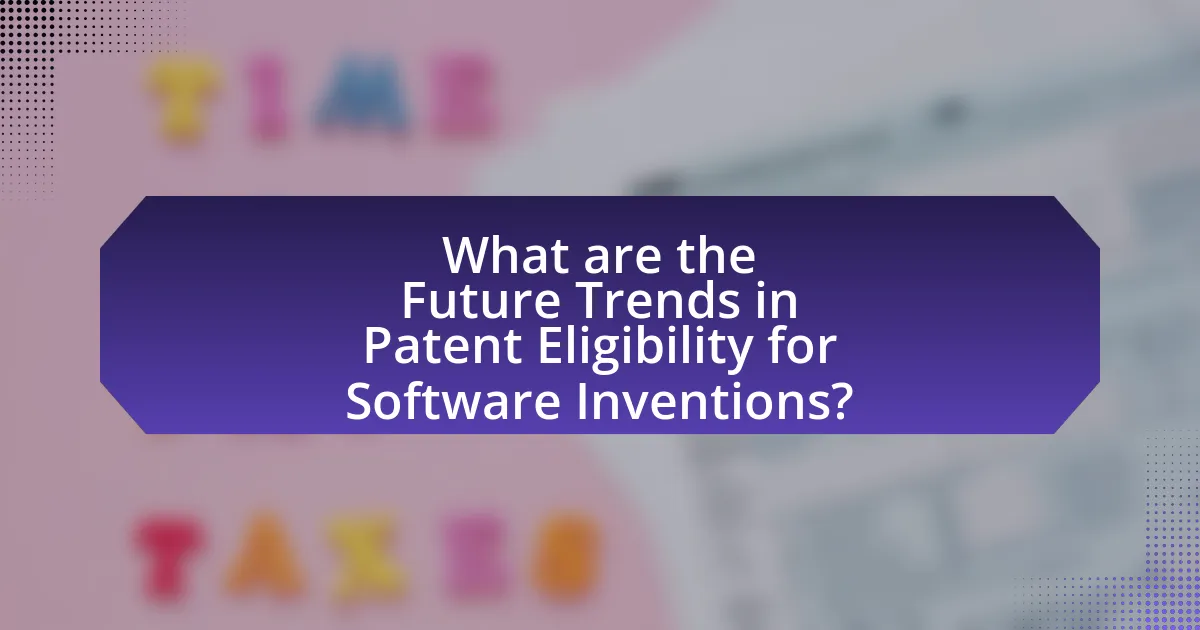
What are the Future Trends in Patent Eligibility for Software Inventions?
Future trends in patent eligibility for software inventions indicate a shift towards more stringent requirements for demonstrating technical innovation. Recent court rulings, such as the U.S. Supreme Court’s decision in Alice Corp. v. CLS Bank International, have established a two-part test that requires software inventions to show both an abstract idea and an inventive concept that adds significantly more to the idea. This trend suggests that software patents may increasingly require clear technical advancements or unique applications of algorithms to qualify for protection. Additionally, the growing emphasis on artificial intelligence and machine learning technologies is likely to influence patent eligibility criteria, as these fields often blur the lines between abstract ideas and concrete inventions.
How is technology evolving the landscape of software patent eligibility?
Technology is evolving the landscape of software patent eligibility by introducing new frameworks and legal interpretations that adapt to advancements in software development. For instance, the rise of artificial intelligence and machine learning has prompted courts and patent offices to reconsider what constitutes a patentable invention, often focusing on the technical implementation rather than abstract ideas. The U.S. Supreme Court’s decision in Alice Corp. v. CLS Bank International established a two-step test for determining patent eligibility, which has led to increased scrutiny of software patents that do not demonstrate a specific, practical application. This shift reflects a broader trend where technological advancements necessitate a reevaluation of existing legal standards to ensure that patents promote innovation rather than hinder it.
What emerging technologies are influencing patent eligibility standards?
Emerging technologies such as artificial intelligence, blockchain, and biotechnology are significantly influencing patent eligibility standards. These technologies challenge traditional notions of what constitutes a patentable invention due to their unique characteristics, such as the ability to generate new ideas autonomously or the decentralized nature of blockchain. For instance, the U.S. Patent and Trademark Office has issued guidelines that specifically address the patentability of AI-generated inventions, reflecting the need to adapt existing legal frameworks to accommodate innovations that do not fit neatly into established categories. Additionally, the rise of biotechnology has led to ongoing debates regarding the patentability of genetic materials and processes, prompting courts to reevaluate criteria like utility and non-obviousness. These developments illustrate the dynamic interplay between technological advancement and legal standards in the realm of patent eligibility.
How might changes in legislation affect future software patents?
Changes in legislation can significantly impact future software patents by altering the criteria for patent eligibility and enforcement. For instance, the introduction of stricter standards for what constitutes a patentable invention could limit the scope of software patents, making it more challenging for developers to secure protection for their innovations. Historical context shows that the U.S. Supreme Court’s decision in Alice Corp. v. CLS Bank International in 2014 tightened the standards for software patent eligibility, leading to a decline in granted software patents. This demonstrates how legislative shifts can directly influence the landscape of software patenting, potentially stifling innovation or encouraging more robust patent applications depending on the direction of the changes.
What best practices should inventors follow for successful software patents?
Inventors should follow several best practices for successful software patents, including ensuring novelty, providing detailed descriptions, and demonstrating utility. Ensuring novelty involves conducting thorough prior art searches to confirm that the software invention is unique and not previously disclosed. Providing detailed descriptions is crucial; the patent application must clearly articulate how the software works, including algorithms and processes, to meet the requirements set by patent offices. Demonstrating utility means showing that the software has a specific, substantial, and credible use, which is essential for patent eligibility. These practices align with the standards established by the United States Patent and Trademark Office, which emphasizes clarity and specificity in patent applications to avoid rejections.
How can thorough documentation improve patent applications?
Thorough documentation can significantly improve patent applications by providing clear and comprehensive evidence of the invention’s uniqueness and functionality. This detailed record helps patent examiners understand the technical aspects and innovative features of the software invention, reducing the likelihood of rejections based on insufficient information. For instance, a study by the United States Patent and Trademark Office (USPTO) indicates that well-documented applications have a higher success rate in overcoming initial rejections, as they facilitate a more efficient examination process. Additionally, thorough documentation can help establish the invention’s prior art context, ensuring that the application meets the novelty and non-obviousness criteria essential for patent eligibility.
What role does prior art research play in the patent process?
Prior art research is crucial in the patent process as it helps determine the novelty and non-obviousness of an invention. By examining existing patents, publications, and other relevant materials, applicants can assess whether their invention is sufficiently different from what has already been disclosed. This research is essential because, according to the United States Patent and Trademark Office (USPTO), an invention must be novel to qualify for patent protection. If prior art reveals that the invention has already been made or is obvious based on existing knowledge, the patent application may be rejected. Thus, thorough prior art research not only strengthens the patent application but also informs inventors about the competitive landscape and potential challenges.
